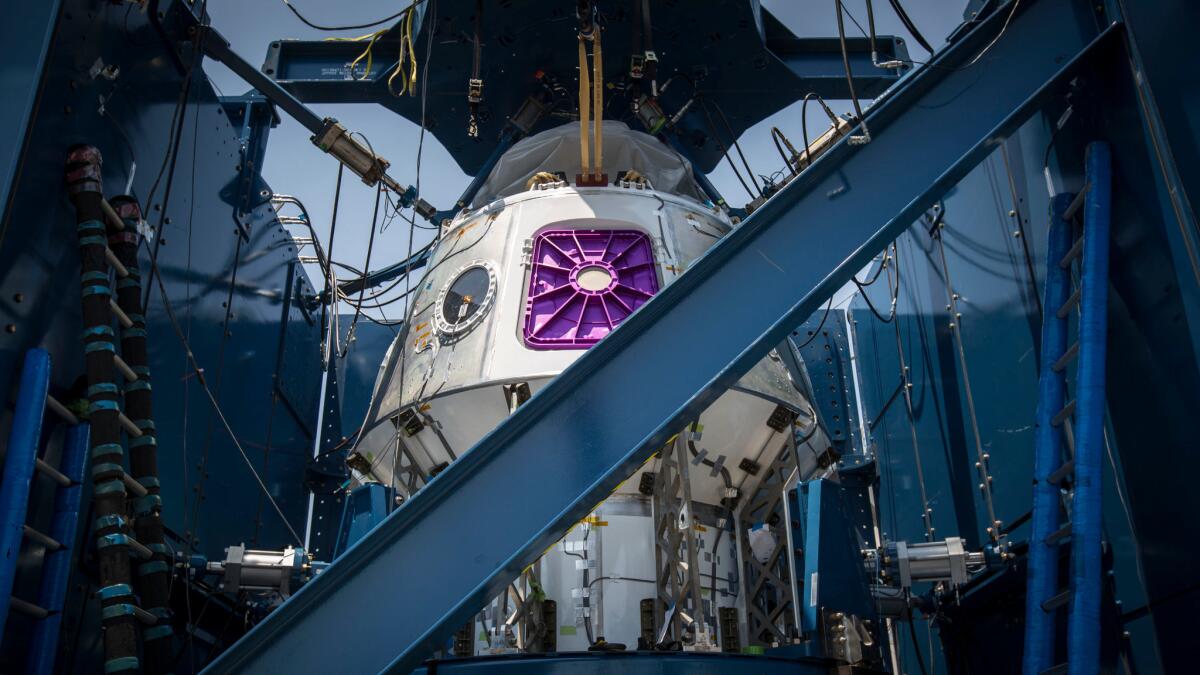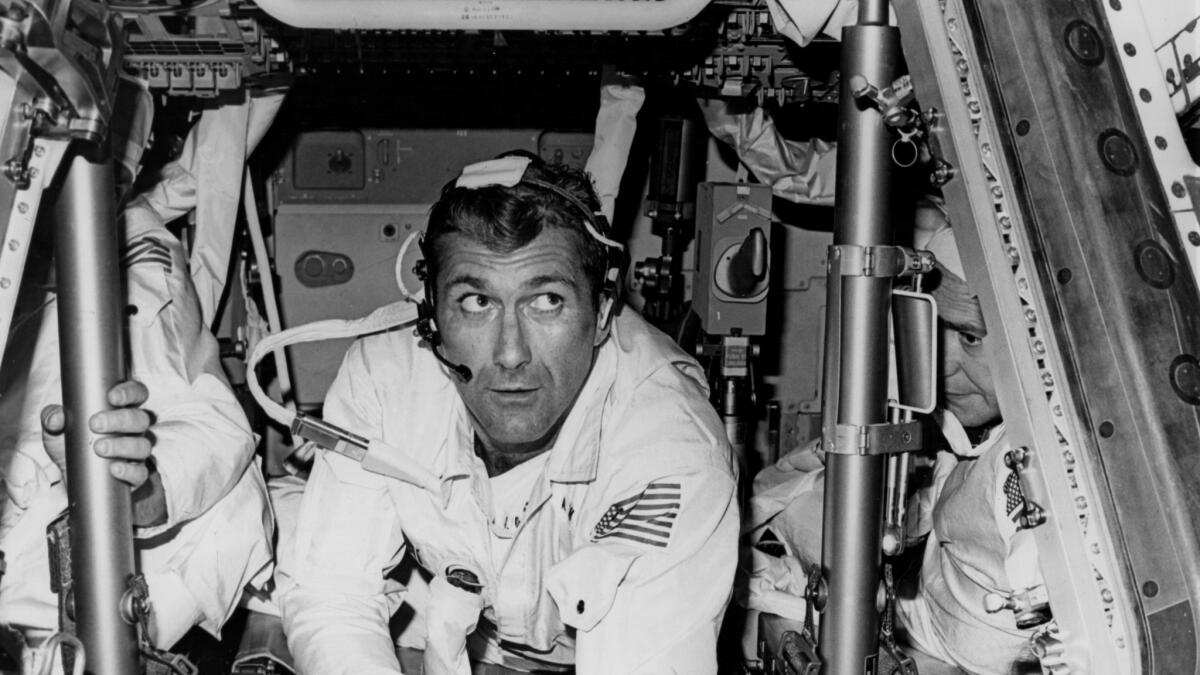Southern California’s aerospace industry, long in decline, begins to stir

- Share via
When Tim Buzza joined McDonnell Douglas Corp. in the late 1980s and worked on the C-17 cargo plane, lots were so jammed that workers often had to park as much as a mile from the Long Beach plant and take a shuttle bus.
Last year, the C-17 production line shut down, ending the last large aircraft assembly operation in the region. Today, Buzza, 52, works on the old Douglas property, but for Virgin Galactic, billionaire Richard Branson’s space start-up.
Southern California is a long way from its aerospace glory years. Employment today is about one-third of what it was in 1990.
But analysts and industry leaders believe that the sector is poised to grow again, behind a new generation of entrepreneurial private space companies like SpaceX in Hawthorne and Virgin Galactic, and defense projects such as the B-21 long-range strike bomber, which could bring thousands of jobs to the area.
“From the peak in the late ‘80s, we’re at a fraction of what it was then,” said Jim Adams, principal with PricewaterhouseCoopers Strategy&. “But at the same time, the aerospace and defense sector in Southern California is far from dead.”
Southern California — with its ideal climate, open land and high-powered universities — has been a major player in the aerospace industry since the early 20th century.
In the 1920s, more than 25 airframe and aircraft engine makers set up shop in the area, and companies like Carson-based Ducommun Inc. supplied aluminum to early aircraft like Charles Lindbergh’s Spirit of St. Louis.
Over the course of World War II, Southern California aircraft manufacturing plants employed 2 million people and built 300,000 planes, according to the book “Blue Sky Metropolis: The Aerospace Century in Southern California.”
Douglas Aircraft, for example, churned out more than 100 C-47 cargo planes, A-20 attack bombers and B-17 bombers each week.
With the advent of the Cold War, Southern California became the nation’s hub for high-tech weapons research. Simon Ramo, co-founder of aerospace giant TRW Inc., pioneered the development of the U.S. intercontinental ballistic missile system, first in a former barbershop in Westchester, then in a former Catholic church in Inglewood.
In the heyday of the 1960s space program, North American Aviation’s Downey facility scaled up to 25,000 workers to build the Apollo command module.
It’s hard to overstate the extent to which postwar Southern California was built on defense spending. In his definitive account of the period, “Golden Dreams: California in an Age of Abundance, 1950-1963,” Kevin Starr wrote: “The Department of Defense awarded one-quarter of all its contracts to California in the 1950s. Between 1952 and 1962, the Department of Defense funneled more than $50 billion into California, twice the amount received by any other state.”
“You had this kind of cauldron of intellectual and entrepreneurial ferment,” said Ron Sugar, former chief executive of Northrop Grumman from 2003 to 2010. “It was really remarkable.”
Employment surged again when President Reagan launched a new military race with the Soviet Union. More than 1,000 Northrop workers swarmed over B-2 bomber production lines in Palmdale.
But the industry ebbed as the Cold War ended and Pentagon spending slumped. Companies consolidated. Hundreds of thousands of workers were laid off.
Defense giants like Lockheed Corp. and Northrop Grumman Corp. later uprooted their headquarters from Southern California to move closer to military and intelligence customers in the Washington, D.C., area.
Today, the region’s private aerospace industry employment is down to 92,000, compared with 273,000 in 1990.

“There’s always been this cyclical nature to the industry,” said Peter Westwick, an adjunct professor of history at USC and editor of “Blue Sky Metropolis.” “It’s not as big as it was 50 years ago, but there’s still a substantial footprint here.”
The industry is now more diverse. Big programs include space launch-service providers and various satellite makers as well as drone manufacturers, such as Monrovia’s AeroVironment Inc.
The drone industry, in particular, is one of Southern California’s new strong points.
AeroVironment has emerged as the largest supplier of small, unmanned aircraft systems to the Pentagon, and spy drones such as Global Hawk and Triton are assembled by Northrop in Palmdale. Boeing’s unmanned undersea vehicles are made at its Phantom Works facility in Huntington Beach.
A more diverse customer base may help smooth the notorious employment downturns, which were usually driven by federal budget cuts or the end of big contracts. SpaceX, Virgin Galactic and Los Angeles-based launch company Rocket Lab have all filled their satellite-launch manifests with both government and commercial contracts.
There’s probably more rocket engine and launch vehicle expertise in Southern California than anywhere else in the United States or probably the world.
— Jim Cantrell, CEO of Vector Space Systems
“It won’t be the gold rush it was during Apollo or the space shuttle,” said Greg Autry, assistant professor of clinical entrepreneurship at USC. “But it’s much more sustainable.”
Billionaire-backed firms like Elon Musk’s SpaceX, Branson’s Virgin Galactic and Microsoft co-founder Paul Allen’s Vulcan Aerospace have their founders’ deep pockets and personal commitments to fuel ambitious plans, such as missions to Mars or sending tourists into space.
The industry also is geographically dispersed. Out in Mojave, Vulcan Aerospace is building Stratolaunch, a plane that will have the largest wingspan ever and is to launch satellites into orbit. Other companies like XCOR Aerospace Inc. and micro-satellite launch firm Vector Space Systems have established facilities in the desert city, where open land allows for rocket test firings.
Vector is based in Tucson but its engineering operations are in Huntington Beach, a decision made because of the deep knowledge of rocketry in the region, said Jim Cantrell, the company’s chief executive.
”There’s probably more rocket engine and launch vehicle expertise in Southern California than anywhere else in the United States or probably the world,” he said.
That combination of concentrated brainpower and favorable climate have enabled the region — so far — to largely overcome its high costs and transportation issues.
“L.A.’s got something different that nobody can compete with,” said Chad Anderson, managing director of Space Angels Network, an early-stage investor group in private space companies. “They’ve got a fantastic desert and an operational spaceport.”
For all the cutting-edge entrepreneurship, big defense programs and commercial aircraft subcontracts still hold the most promise for hiring.
Northrop produces the center fuselage for the F-35 fighter jet at its Palmdale facility, and more than 100 subcontractors around the region supply parts for the joint strike fighter; together they account for more than 10,000 direct and indirect jobs. The program is slated to enter full production in 2019.
Southern California will also play a role in the B-21 bomber. Few technical details have been released about the plane, which will be designed to evade radar and could potentially be controlled either by an onboard crew or remotely, according to a Congressional Research Service report released in April.
See the most-read stories in Business this hour »
Last year, local government leaders said Northrop told them it planned to construct most of the plane at the Air Force Plant 42 complex in Palmdale, although a military trade publication reported that program employees are also being hired in Melbourne, Fla.
The bomber is expected to enter service in the mid-2020s. The ripple effect of the program can already be seen in the handful of new hotels that are scheduled for approval in Palmdale, based partly on anticipated lodging needs of program employees traveling in and out of the area, Mayor James Ledford said.
Even if all of the planned 100 B-21s are built, employment probably won’t match the levels of the big defense programs of the 1940s, ‘60s and ‘80s. Like most forms of manufacturing today, aircraft are built with a high degree of automation.
Just 20-plus years ago, the C-17 was designed on vellum by hundreds of designers clustered around drafting tables in football field-sized rooms. Now most of that work is done digitally.
L.A.’s got something different that nobody can compete with.
— Chad Anderson, managing director of Space Angels Network
At Northrop’s Palmdale facility, an integrated assembly line for the F-35 center fuselage is aided by robotics. Companies such as Aerojet Rocketdyne and Virgin Galactic have installed machines that make parts through 3-D printing to reduce time and costs of production.
Buzza, the former C-17 engineer, knows firsthand about that shift. He once worked side-by-side with thousands of co-workers at McDonnell Douglas, but today he is one of just 200 people at Virgin Galactic. He is vice president of development for the satellite-launching unit of the company.
“You’ll see just a growth in smaller aerospace companies staying in Southern California and continuing to grow,” he said. “There’s a long tradition of both engineers and technicians that have grown up hearing about what their parents do or seeing what their parents do, and I think that will just continue.”
For more business news, follow me @smasunaga
MORE BUSINESS NEWS
Elon Musk’s master plan for Tesla is long on vision, short on specifics
California boosts payrolls by 40,300 workers in June, but unemployment rises to 5.4%
Obama administration moves to block health insurance mega-mergers
More to Read
Inside the business of entertainment
The Wide Shot brings you news, analysis and insights on everything from streaming wars to production — and what it all means for the future.
You may occasionally receive promotional content from the Los Angeles Times.











